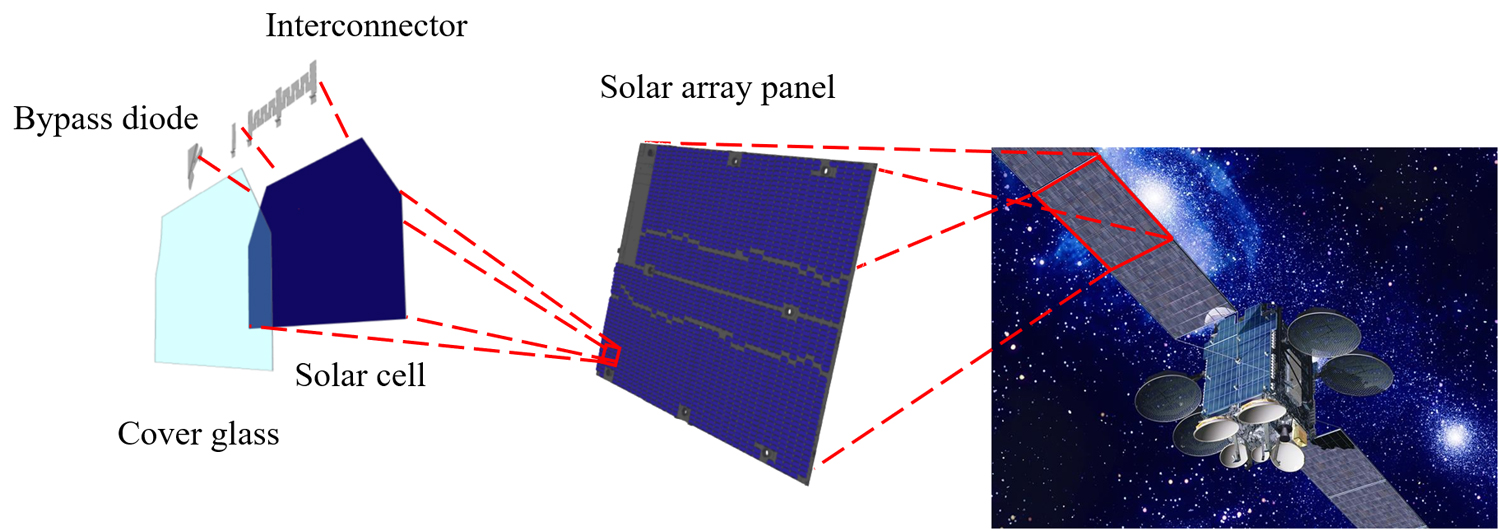News
Note that the releases are accurate at the time of publication but may be subject to change without notice. This page shows only the most recent items. For the full archive of press releases please click "Search by category or year."
Mitsubishi Electric Selected as Representative Organization for JAXA’s Space Strategy Fund to Develop Solar Cells and Related Components for Satellites

Configuration of solar array
TOKYO, August 21, 2025 - Mitsubishi Electric Corporation (TOKYO: 6503) announced today it has been selected as a representative organization for the technology development titled “Development of Domestic Solar Cells, Cover Glass, and Solar Arrays” under the “Development/Verification of Parts/Components for the Establishment of Satellite Supply Chain,” one of the technology development themes included in the 1st Phase of the Space Strategy Fund1 operated by the Japan Aerospace Exploration Agency (JAXA). The company has signed a contract with JAXA covering this development.
In recent years, with the expansion of the satellite market, including low earth orbit satellite constellations,2 the demand for solar cells onboard satellites and cover glass to protect solar cells from space radiation has increased, and a global supply shortage has caused high prices and long delivery times.
As part of this project, Mitsubishi Electric will develop low-cost, mass-producible solar cells in collaboration with domestic suppliers who have expertise in the solar cell field. In addition, the company will verify the applicability of glass used for ground-based products to the space environment and work toward the mass production of low-cost cover glass. Furthermore, Mitsubishi Electric will develop new solar arrays incorporating the new solar cells and cover glass, aiming to enable smoothly integrated domestic production of these. The company will help to strengthen the domestic satellite supply chain by reducing the cost of solar arrays and their components and strengthening supply capabilities.
In the development of solar cells, which are particularly important components, Mitsubishi Electric will collaborate with Japan-based PXP Corporation, which possesses cutting-edge technology in the solar cell field and conducts research and development on next-generation photovoltaic conversion elements,3 including perovskite structures4 and CIGS.5 The collaboration will focus on research into the practical application of perovskite/CIGS tandem solar cells—cells that combine both perovskite solar cells and CIGS solar cells—in the space environment. These solar cells have conversion efficiency equivalent to conventional products6 and are expected to maintain conversion efficiency while having higher resistance to space radiation than conventional products. Additionally, both perovskite solar cells and CIGS solar cells can be manufactured more easily, more cheaply and in greater bulk than conventional products. The combination of the advanced solar cell manufacturing technology of PXP and Mitsubishi Electric’s extensive satellite system development and manufacturing technology will facilitate the cost-effective mass production of solar cells that maintain high reliability and conversion efficiency, even in space.
Natsuki Asano, Senior Manager, Solar Array & Composite Engineering and Project Section, Satellite Mechanical Components Department, Kamakura Works, Mitsubishi Electric Corporation, who will lead the representative organization, said, “We are very pleased to have been selected as a representative organization for the Space Strategy Fund. Through the practical implementation of solar arrays equipped with domestically produced solar cells and cover glass that balance low cost and high performance, while ensuring resistance to the space environment and enabling mass production, we will help strengthen Japan’s satellite supply chain and enhance the international competitiveness of the country’s space industry.”
- 1
A fund established in JAXA by the Cabinet Office, Ministry of Internal Affairs and Communications, Ministry of Education, Culture, Sports, Science and Technology, and Ministry of Economy, Trade and Industry to support advanced technology development, technology demonstration, and commercialization in the space sector by private companies and universities.
- 2
A system that deploys numerous small satellites in low Earth orbit (approximately 200 to 2,000 kilometers in altitude) to function collaboratively.
- 3
A new type of element that has superior efficiency and performance in converting light to electricity compared to conventional technologies. It is used in fields such as solar cells and optical sensors, with expectations for improved energy conversion efficiency and the realization of new functionalities.
- 4
A type of crystal structure of compounds that shares the same crystal structure as perovskite (calcium titanium). Compounds with a perovskite structure are attracting attention as materials for next-generation solar cells due to their high conversion efficiency, low cost, and flexibility.
- 5
An abbreviation for compound semiconductor materials primarily composed of copper (Cu), indium (In), gallium (Ga), and selenium (Se). It is used as a material for solar cells.
- 6
Currently mainstream III-V solar cells.
Inquiry
Search by category or year of publication
There are no articles for the condition you specified.
